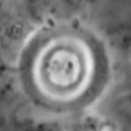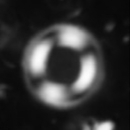Denisea aliquanta
Set number: 526
-
1
-
2
-
3
-
4
-
5
-
6
-
7
-
8
-
9
-
10
-
11
-
12
10µm
Set number: 525
-
1
-
2
-
3
-
4
-
5
-
6
-
7
-
8
-
9
-
10
10µm
Set number: 520
-
1
-
2
-
3
-
4
-
5
-
6
-
7
-
8
-
9
-
10
-
11
-
12
10µm
Set number: 521
-
1
-
2
-
3
-
4
10µm
Set number: 522
-
1
-
2
-
3
-
4
10µm
Set number: 523
-
1
-
2
-
3
-
4
-
5
-
6
-
7
-
8
10µm
Set number: 524
-
1
-
2
-
3
-
4
10µm
Ericsonia aliquanta Bown, 2016
Cycloplacolithella kavaryi Haq, 1971; Invalid according to ICN Art. 35.1
The specimens of Denisea, with a size range between 5.0 μm and 9.0 μm and a wide central area, are assigned to Denisea aliquanta. The diameter of the central area is greater than the width of the pelaga but not twice as much.
Denisea aliquanta differs from the similar-sized Denisea subpertusa by having a wider central area than the width of the pelaga. In contrast, the central area diameter is less than the width of the pelaga in Denisea subpertusa. Denisea foramena also has a similar size but differs from Denisea foramena by having a central area at least twice the width of the pelaga. Denisea orbis is distinguished from Denisea aliquanta by being smaller than 5.0 μm, while Denisea constricta, Denisea magna and Denisea polymegalo are larger than 9.0 μm. Denisea polymegalo is further distinguished by having a central area that is at least twice the width of the pelaga, whilst Denisea constricta also further differs by having a narrower central area than the width of the pelaga.
Bown, P. R. 2016. Paleocene calcareous nannofossils from Tanzania (TDP sites 19, 27 and 38). Journal of Nannoplankton Research. 36(1): 1-32.
Varol, O. 2022. Denisea, a new genus of Paleocene calcareous nannofossils. Neues Jahrbuch für Geologie und Paläontologie, Abhandlungen, 304/2 (2022): 159-186.

